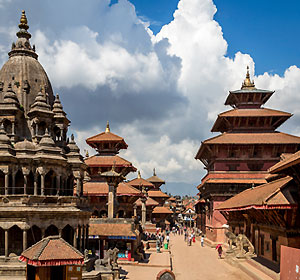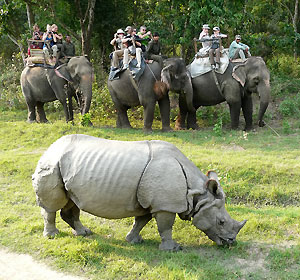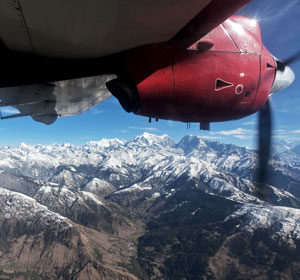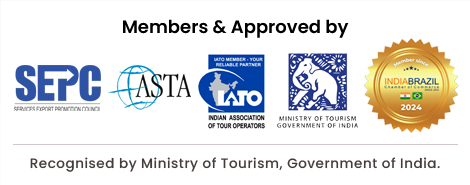T he land of mountains and monasteries, Nepal is a trekkers’ paradise. Offering magnificent Himalayan views, golden temples, lovely hill villages, and wildlife adventure, Nepal is one of the world’s most spectacular travel destinations. Indian Holiday offers Nepal tours combining the best of the country, providing an unforgettable experience of your life. 8 out of 10 of the world’s highest mountains are located in Nepal, giving mountaineers a chance to go on challenging treks. These include Mount Everest, Kanchenjunga, Manaslu, Cho Oyu, Lhotse, Makalu, Annapurnas, Dhaulagiri, and so on. The incredible mountain scenery that Nepal offers is nowhere to be seen in the world.
The country invites adventure-lovers from around the world to experience rafting the roaring Nepali river, bungee jumping into a Himalayan gorge, or indulging in kayaking, paragliding, mountain biking, or canoeing, with some of the world’s most dramatic landscapes. The south of Nepal has a chain of wild national parks, perfect for nature buffs to scan the subtropical treetops and witness exotic bird species. Scour the jungles for rhinos, crocodiles, and tigers. A luxury safari lodge in central Chitwan or exploring the remote Bardia or Koshi Tappu on a wild trip might be one of the prime highlights of a Nepal visit.

Nepal comprises the largest part of the country as a middle hill and Lower Himalaya, which accommodates almost 68% of the population of the country. The region experiences a temperate climate and the land here is far more fertile than in the upper Himalayan region. Kathmandu is the capital of Nepal and lies in this region. Some of the popular tourist destinations such as Pokhara and Tansen are also situated in this belt.
Kathmandu is snuggled in a valley and encompassed by the lush green dense forest. It is the biggest city in Nepal and there are several traditional villages and hidden ancient temples within its proximity. The city offers panoramic views of the mountains and at the high end, the region comprises the mountain ranges of 4000 m above sea level. In contrast, the Churia range is lower in comparison.

The plain region of Nepal is called the Tarai region, which comprises 17% of the land. The plain region stretches from the far-west to the far-east and covers the country's entire southern part. This region experiences a sub-tropical climate, and the land here is enormously fertile and produces the bulk of the food grains. The Tarai region is the most productive region of the country. The majority of the industries are situated in this region. Chitwan National Park, Bardia National Park, Shukla Phanta Wildlife Reserve, and the Koshi Tappu Wildlife Reserve lie in this belt and comprise endangered species such as the elusive Royal Bengal Tiger, the One-horned rhinoceros, and Gangetic dolphins, along with the rare species of birds.

Nepal is renowned for accommodating the eight of the fourteen highest peaks in the world exceeding 8000 m above sea level, namely Mount Everest, Kanchenjunga, Lhotse, Makalu, Cho Oyu, Dhaulagiri, Manaslu, and Annapurna. These mountains are situated in the Upper Himalayas region of Nepal, and this belt ranges from 4,000 m above sea level to 8,848 m above sea level. This region comprises 15% of the total area of Nepal. The Upper Himalayas region is icy, windy, and uninhabitable. While the region immediately below them is inhabited, the land is less fertile here.
USEFUL INFORMATION
A valid passport with six months of validity or more is required when entry into Nepal. The passport at least has one blank visa page for an entry visa. Visas can be obtained in advance of travel or purchased upon arrival at Tribhuvan International Airport in Kathmandu.
ENTRY TO NEPAL
Nepal Embassy/Consulate or Mission offices abroad issue the tourist entry visa for Nepal. Tourists can also obtain a visa from the following immigration offices in Nepal:
- Tribhuvan International Airport, Kathmandu
- Kakarvitta, Jhapa (Eastern Nepal)
- Birganj, Parsa (Central Nepal)
- Kodari, Sindhupalchowk (Northern Border)
- Belhiya, Bhairahawa (Rupandehi, Western Nepal)
- Jamuna, Nepalgunj (Banke, Mid Western Nepal)
- Mohana, Dhangadhi (Kailali, Far Western Nepal)
- Gaddachauki, Mahendranagar (Kanchanpur, Far Western Nepal)
FEES FOR TOURIST VISA OF NEPAL
- Multiple entries with the validity of 15 days cost US$ 25 or equivalent convertible currency
- Multiple entries with the validity of 30 days cost US$ 40 or equivalent convertible currency
- Multiple entries with the validity of 90 days cost US$ 100 or equivalent convertible currency
FEES FOR TOURIST VISA EXTENSION
The visa extension fee for 15 days or less is the US $30 or equivalent convertible currency while the visa extension fee for more than 15 days is US$ 2 per day. The tourist visa can be extended for a maximum period of 150 days in a single visa year (January – December).
GRATIS OR FREE VISA FOR SAARC COUNTRIES
Gratis visa for 30 days is only available for tourists of SAARC countries.
CONDITION AND FEES FOR TRANSIT VISA
Tourists can obtain a transit visa for one day from Nepal's immigration offices at the entry points upon demonstration of departure flight ticket via Tribhuvan International Airport in Nepal, by paying the US $5 or equivalent convertible currency. For more details http://www.nepalimmigration.gov.np/page/tourist-visa
BUSINESS HOURS IN THE VALLEY REGION
The working hours for banks are from 10:00 A.M to 3:30 P.M from Sunday to Thursday. On Fridays, banks remain open until 12:00 P.M only and closed on Saturdays. The government offices open from 9:00 A.M to 5:00 P.M. from Monday to Friday. While the working hours for business offices are from 10:00 A.M to 5:00 P.M from Sunday to Friday. Embassies and international organisations open from 9:00 A.M to 5:00 P.M from Monday to Friday. And the shops from 10:00 A.M to 8:00 P.M and are usually closed on Saturdays.
BUSINESS HOURS OUTSIDE THE VALLEY REGION
The working hours for government offices are from 10:00 A.M to 5:00 P.M. Sunday to Thursday. On Fridays, the offices hours are till 3:00 P.M and on Saturdays are closed. Banks open from 10:00 A.M to 3:00 P.M. from Sunday to Thursday. On Fridays, banks remain open until 12:00 P.M only. Business offices open from 10:00 A.M to 5:00 P.M from Sunday to Friday. The working hours for Embassies and international organisations are from 9:00 A.M to 5:00 P.M from Monday to Friday. Shops open from 10:00 A.M to 8:00 P.M and are usually closed on Saturdays.
Nepal is 5 hours 45 minutes ahead of GMT.
Nepal experiences the typical climate which varies as per its geography and altitude. From October to May the region experiences the dry season and the monsoon season occurs from June to September. The best time to visit Nepal is from September to November when the dry season starts. The countryside adorned with the lush greenery after the monsoon season and during this time Nepal is at its most beautiful phase. During this season there are plenty of colourful festivals to enjoy.
Passengers arriving at Tribhuvan International Airport (TIA) have to declare all their baggage and get clearance through the customs at the port of entry. The passengers without any dutiable goods can proceed through the Green Channel for quick clearance without a baggage check. However, if you are carrying dutiable articles, you have to pass through the Red Channel for detailed customs clearance.
CONDITIONS FOR IMPORT IN NEPAL
The visitors are allowed to bring duty-free products to Nepal such as cigarette, cigars, liquor, apart from their personal belongings. You can also bring the duty-free articles on condition that you take them out with you when you leave: binoculars, movie or video camera, still camera, laptop computer, and portable music system.
CONDITIONS FOR EXPORT FROM NEPAL
Visitors are advised not to purchase the objects which are over 100 years old such as sacred images, paintings, manuscripts as these are valued for culture and religious reasons. These items belong to Nepal's cultural heritage and belong from here, it is not allowed to take them with yourself. The Department of Archaeology at Ramshah Path near Singha Durbar has to certify all metal statues, sacred paintings and similar objects before they are allowed to be sent or carried out of the country. If you want we can assist you in this process.
For more information on customs matters, contact the Chief Customs Administrator, TIA Customs Office; tel: 4470110, 4472266.
AIRPORT TAXES IN NEPAL
Civil Aviation of Nepal has announced a hike in the airport taxes at the Tribhuvan International Airport (TIA) and other domestic airports from 2002/02/19, with the immediate effect. The new Airport Tax is equally applicable to Nepalese as well as non-Nepalese citizens flying from Nepal.
Tourists can consult with their physician and get a complete check-up before the departure. Nepal does not require any particular immunisation for your visit. Vaccinations for Cholera, Meningitis, Tetanus & Diphtheria, Typhoid and Gamma Globulin should be considered for your trip. Most of the hotels have a doctor on call.
High mountainous regions experience the stronger sunshine than you are used to and it can cause heat or digestive upsets, insect bites for which you have developed no immunities. All these things can spoil your trip. So please take a few basic precautions and carry a kit which comprises sunscreens and other lotions for protection from the sun, insect repellents and sting relief creams, water sterilising tablets and medicines for possible stomach upsets or indigestion. Use insect repellent on exposed skin and wear socks, trousers, and long-sleeved shirts during the evening, to protect yourself from mosquitoes.
WHAT TO EAT AND DRINK WHILE TRAVELLING TO NEPAL?
Drink the purified water and try not to drink directly the tap water as it is not purified. It is safer to stick to bottled water. It is advisable to avoid ice in your drinks outside your hotel. Avoid ice cream or food sold by roadside vendors, uncooked or undercooked foods, fruit or vegetables that cannot be peeled.
English is widely spoken and understood in urban centers and especially in areas that are frequented by tourists. However, accents and grammar may vary considerably. Different ethnic groups have their language or dialects, but Nepalese is the national language. The script is Devanagari.
Note: We always ensure that our clients are paired with guides who can speak their language.
WAYS OF COMMUNICATION
The major cities like Kathmandu and Pokhara are well-equipped with cyber cafes and communication shops where tourists can make long-distance calls and access internet services. You can receive and send the fax and provide a computer for internet access for a fee. These shops comprise the landlines from which you can make direct calls. Fax and Telex facilities are now ubiquitously available. Internet facilities are also readily available in most cities and tourist centers, cybercafes, and business centers, but free wireless connectivity is rare.
The hotels' wireless or conventional broadband services tend to be many times more expensive than cybercafes in the same areas. The postal service is relatively comprehensive, and you are likely to find post offices in the most remote towns of the country. You can usually buy stamps and leave letters for posting at most hotels.
The markets of Nepal are so vibrant and colourful. The crowded bazaars and roadside markets also lure a large number of tourists. There are several modern malls and air-conditioned hotel arcades where people can visit and enjoy shopping. Most of the shops and clothing stores have fixed price tagged on the goods. However, we would be happy to provide you with expert shopping assistance.
Nepal is renowned for its cultural diversity, which comprises many ethnic groups. All have their specialties, which provide ample space for the growth of several cuisines. Hence, Nepalese cuisine encompasses a whole array of different cuisines rather than one type of cuisine. Dal Bhat is a lentil soup served over boiled rice, a staple dish of Nepal.
Snacks commonly eaten include popped or parched corn, Chiura (beaten rice), Samosa (turnovers stuffed with meat or vegetables), biscuits or packaged cookies, and Indian-style sweets.
The famous beverages comprise tea, usually taken with milk and sugar, and Jard, a homemade beer made from rice, Sharbat, or juice. Raksi is a spirit made in rustic distilleries. At higher elevations, Chang or millet beer is a famous local beverage.


